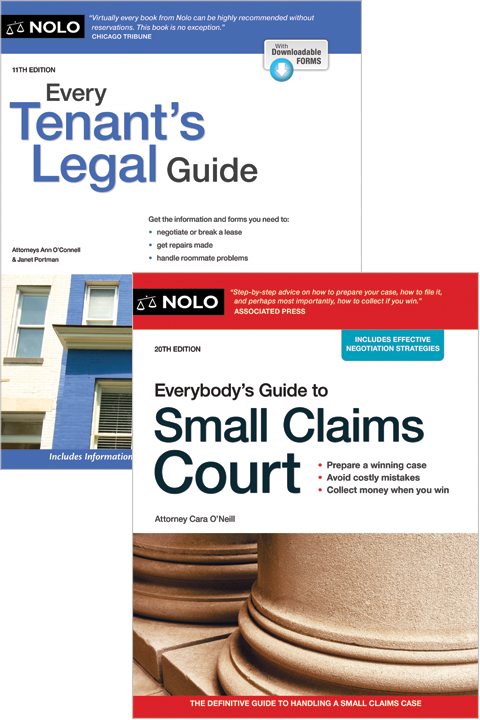Recording the condition of the rental at move-in is just one step in safeguarding your security deposit.
During the process of moving into a new apartment, the last thing on your mind is moving-out day, but since your landlord is probably holding a sizable chunk of your money in the form of a security deposit, it's risky not to prepare for the end of your tenancy right from the beginning.
Before you start unpacking dishes and hanging prints on the walls, take a few simple steps to avoid the misunderstandings and disagreements that have made disputes over security deposits legendary.
Get a Receipt for Your Security Deposit
Many states require landlords to provide tenants with a written receipt for the security deposit. Even if it's not required by law, you can ask your landlord to provide you with one. It doesn't have to be anything fancy—just a written record of how much you paid, the method by which you paid it (for example, by check or Venmo), and the date on which you paid.
Some states' laws also require the landlord to inform tenants about where the security deposit will be held (for example, the name and location of the bank), and whether you'll be entitled to receive interest on your security deposit.
Your landlord should sign the receipt, but if they don't, it's okay to sign it yourself and keep it in your records.
Thoroughly Inspect Your Rental Before Moving in
Give your unit a thorough inspection before you move in. (Better yet, do it before you sign the lease!) Inspecting the rental before bringing all your furniture and belongings will make it easier to spot problems.
Check for damage, dirt, mildew, and obvious wear and tear. Don't neglect to check out things that might not be readily apparent, such as water pressure and sink drainage in the kitchen and bathrooms, the operation of appliances, the appearance of floors and walls, and the condition of the pads under the carpet.
Use a Move-In Checklist
Make a detailed inventory of what you find. The best way to do this is with a good checklist. The more you record about the unit when you move in, the better position you'll be in when moving out to show that certain problems already existed before you moved into the unit.
In some states, landlords are required to give new tenants a written statement on the condition of the unit at move-in time, including a comprehensive list of existing damage. Check your state security deposit rules for the exact requirements in your state, including the type of inspection required at the end of the tenancy.
Regardless of whether it's required by law, many landlords provide a checklist to new tenants, but some do not. You can write up a checklist yourself or use one such as the Landlord-Tenant Checklist available in the Nolo store.
Ideally, you and your landlord should fill out the checklist together to prevent any disputes or disagreements. Otherwise, it's smart to bring along a roommate or a friend so that there's at least one other witness to the condition of the unit at move-in time.
If you spot problems, describe specifically what is wrong. Rather than simply noting "damage to carpet," for example, state "cigarette burns, frayed edges in carpet next to picture window." The more detailed you are, the clearer it is that you're not responsible for those damages. You and your landlord should both sign the checklist after completing it. Make a copy so that each of you has one.
At the end of your tenancy, you'll make another inspection of the same items, noting their condition at move-out time. If items that were okay at move-in are now damaged, your landlord may hold you responsible for fixing them, but you'll be protected from being billed for damage that existed before you moved in.
Take Pictures and Video
Besides completing a checklist, it's also a good idea to document the condition of your unit with photographs or video. Any problems that you note in writing in the checklist should be supported by a photo or video.
Whether you take a photo with your phone or use a separate camera, make sure that you're able to note the date and time you recorded the image. If you make a video, clearly state the time and date when the video was made and send the landlord a copy.
Repeat this process when moving out.
How to Get Your Security Deposit Back
State law requires your landlord to return your security deposit within a certain amount of time after you move out. Most of the time, if the landlord keeps any or all of the deposit to cover unpaid rent or to repair damage, the landlord must provide you with an itemization of how they have applied the security deposit.
In a very few states, tenants must provide the landlord with a forwarding address to trigger the landlord's duty to return and account for the security deposit. Regardless of what the law is in your state, it's always a good idea to provide the landlord—in writing—with an address to send the security deposit. At the same time that you provide your forwarding address, you can remind the landlord of the deadline by which you expect to receive your security deposit.
If, despite your efforts, your landlord tries to hold on to some or all of your security deposit when you move, read Nolo's article Get Your Security Deposit Back.
For all the practical and legal information you need to deal with your landlord when moving in and inspecting the rental unit, see Every Tenant's Legal Guide (Nolo).
Talk to a Lawyer
Need a lawyer? Start here.
How it Works
- Briefly tell us about your case
- Provide your contact information
- Choose attorneys to contact you
- Briefly tell us about your case
- Provide your contact information
- Choose attorneys to contact you



